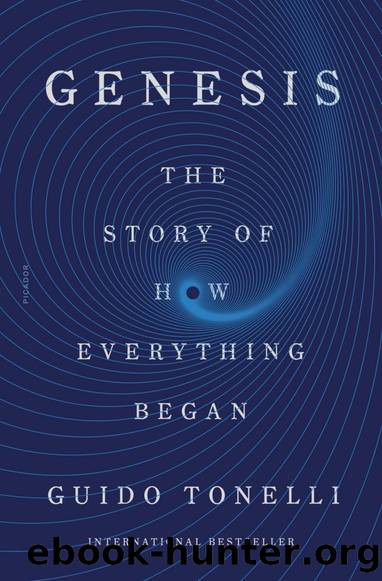Genesis: The Story of How Everything Began by Guido Tonelli

Author:Guido Tonelli [Tonelli, Guido]
Language: eng
Format: epub
ISBN: 9780374600488
Amazon: 0374600481
Barnesnoble: 0374600481
Goodreads: 53317438
Publisher: Farrar, Straus and Giroux
At the end of the first minute there are already seven protons for every neutron, and the density of energy has lowered to the point at which they can begin to aggregate among themselves and form the nuclei of the lighter elements.
It is a fundamental moment, because the density and temperature of the universe now resemble those of the stars. Protons and neutrons, involved in high-energy collisions, may react to form bound states through the strong force. When a proton couples with a neutron, it becomes the nucleus of deuterium; if two deuterium nuclei fuse, the first nuclei of helium are born. This light element, the nucleus of which is formed by two protons and two neutrons, gets its name from the Greek god of the Sun â and in effect all the hydrogen that feeds the immense nuclear furnace of the stars ends up by becoming helium.
To form its nucleus the two nuclei of deuterium need to fuse together, a process that occurs very easily. The four-part nucleus is very stable because it involves a very high binding energy for each of the components. All of the free residual neutrons will be involved in these quadrilles and vanish from the scene. That is why helium nuclei will account for around 24% of the total mass. The rest will be made up of protons that will remain âsingleâ, ready to be transformed into atoms of hydrogen as soon as circumstances will allow. Here and there, in traces, nuclei of a slightly heavier kind will appear, such as those of lithium and beryllium.
There will only be three minutes for the formation of all the originary nuclei in the universe. At the end of the three minutes, the temperature and density will no longer be high enough to sustain nuclear reactions. And this will be a good outcome, since if the process had continued for a prolonged period the universe would have consumed a vast quantity of free protons in order to construct heavier nuclei. If it had lasted for just ten minutes, almost all of the hydrogen would have disappeared.
The abundance of helium in the universe is a further confirmation of the Big Bang theory. This element is also produced at the heart of stars, but without primordial helium things would not add up. Not even with all the stars that we know to exist in the universe burning hydrogen for 14 billion years would it be possible to produce the abundance of helium that has been measured.
The nuclei created at this time will not undergo any further modification for billions of years, and even today they make up the majority of nuclei existing in the universe. To these will be added, much later, the nuclei of the heavy elements of the periodic table, which will be born in the immense nuclear furnaces of the most massive stars.
Theoretical calculations have estimated that if the difference between proton and neutron mass had been only a little greater, the outcome would have been disastrous.
Download
This site does not store any files on its server. We only index and link to content provided by other sites. Please contact the content providers to delete copyright contents if any and email us, we'll remove relevant links or contents immediately.
| Aeronautics & Astronautics | Astronomy |
| Astrophysics & Space Science | Comets, Meteors & Asteroids |
| Cosmology | Mars |
| Solar System | Star-Gazing |
| Telescopes | UFOs |
Tools of Titans by Timothy Ferriss(8304)
Turbulence by E. J. Noyes(7977)
Secrets of Antigravity Propulsion: Tesla, UFOs, and Classified Aerospace Technology by Ph.D. Paul A. Laviolette(5332)
Astrophysics for People in a Hurry by Neil DeGrasse Tyson(5151)
Room 212 by Kate Stewart(5070)
Design of Trajectory Optimization Approach for Space Maneuver Vehicle Skip Entry Problems by Runqi Chai & Al Savvaris & Antonios Tsourdos & Senchun Chai(5037)
Pale Blue Dot by Carl Sagan(4953)
The David Icke Guide to the Global Conspiracy (and how to end it) by David Icke(4655)
A Journey Through Divination and Astronomy by Publishing Pottermore(4363)
Goodbye Paradise(3761)
Apollo 8 by Jeffrey Kluger(3667)
COSMOS by Carl Sagan(3588)
The Five People You Meet in Heaven by Mitch Albom(3520)
Losing the Nobel Prize by Brian Keating(3518)
How to Read Water: Clues and Patterns from Puddles to the Sea (Natural Navigation) by Tristan Gooley(3431)
Brief Answers to the Big Questions by Stephen Hawking(3392)
How to Read Nature by Tristan Gooley(3290)
The Order of Time by Carlo Rovelli(3162)
A Brief History of Time by Stephen Hawking(2991)
